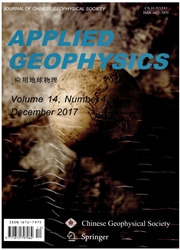

 中文摘要:
中文摘要:
本文推导了简单规则形体(单一边界、双边界和多边界)重力异常垂向一阶导数和重力异常垂向二阶导数零值位置的解析表达式,并研究了其空间变化规律;对难以得到其零值位置解析表达式的简单规则形体,利用其剖面图和断面图上的零值位置来研究其空间变化规律。研究结果表明,重力异常垂向二阶导数与重力异常垂向一阶导数零值位置的空间变化规律基本一致,只是重力异常垂向二阶导数零值位置比重力异常垂向一阶导数的零值位置更靠近地质体上顶面边缘位置,且其分辨能力更强。对于单边界模型,随着埋深的增加,重力异常垂向导数的零值位置均自形体上顶边缘位置向外侧偏移,但最终均能收敛于某一固定值;对于双边界模型,随着埋深的增加,重力异常垂向导数的零值位置自形体上顶边缘位置一直向外侧偏移;对于多边界模型,随着埋深的增加,重力异常垂向导数零值位置自形体上顶边缘位置向外侧收敛,部分边界的零值位置重合并消失。最后通过实际资料检验了方法的有效性和可靠性。
 英文摘要:
英文摘要:
In this paper we deduce the analytic solutions of the first- and second-order vertical derivative zero points for gravity anomalies in simple regular models with single, double, and multiple edges and analyze their spatial variation. For another simple regular models where it is difficult to obtain the analytic expression of the zero point, we try to use the profile zero points to analyze the spatial variation. The test results show that the spatial variation laws of both first- and second-order vertical derivative zero points are almost the same but the second-order derivative zero point position is closer to the top surface edge of the geological bodies than the first-order vertical derivative and has a relatively high resolution. Moreover, with an increase in buried depth, for a single boundary model, the vertical derivative zero point location tends to move from the top surface edge to the outside of the buried body but finally converges to a fixed value. For a double boundary model, the vertical derivative zero point location tends to migrate from the top surface edge to the outside of the buried body. For multiple boundary models, the vertical derivative zero point location converges from the top surface edge to the outside of the buried body where some zero points coincide and finally vanish. Finally, the effectiveness and reliability of the proposed method is verified using real field data.
 同期刊论文项目
同期刊论文项目
 同项目期刊论文
同项目期刊论文
 期刊信息
期刊信息
